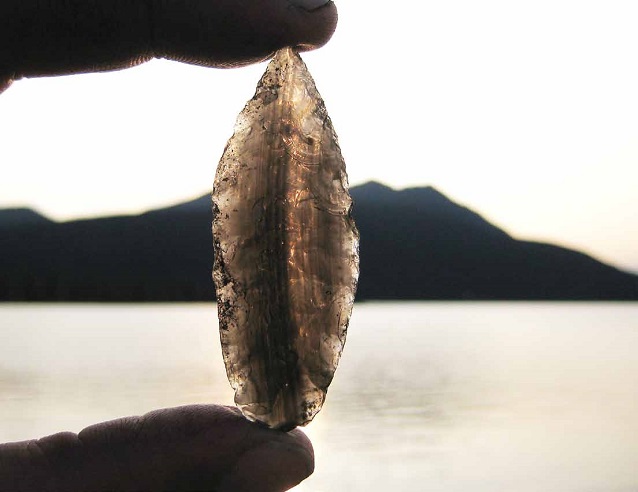
NPS photograph by Andy Tremayne
Abstract
Since the discovery of a prominent obsidian source near the Indian River, a tributary of the Koyukuk (Griffen et al. 1969), numerous researchers have investigated obsidian use in prehistoric Alaska (Cook 1995, Slobodina et al. 2008). Batza Tena, as it is known in the local Koyukon dialect, has been suggested to be the primary archaeological obsidian source in Alaska (Clark and Clark 1993, Cook 1995). Further research identified many other obsidian types associated with sources as far reaching as the Yukon Territory and British Columbia, as well as an even more distant source in Siberia (Cook 1995, Slobodina et al. 2008). These efforts have illuminated evidence of an elaborate network of long distance trade and cultural interaction throughout prehistoric Alaska and beyond.
There are no known geologic obsidian sources in Gates of the Arctic National Park and Preserve, meaning that any obsidian found at archaeological sites had to be procured elsewhere and transported into the region. The relative proximity of the Batza Tena source area (Figure 2) suggests that most obsidian present in archaeological sites in the area originated at this source. While this is generally true, previous research has shown that artifacts made from obsidian sources other than Batza Tena have also been found (Cook 1995). For this project, we sought to exhaustively analyze all archaeological obsidian from Gates of the Arctic in an effort to better understand where past inhabitants had acquired this resource and how it may have been transported throughout the region.

Map by C. Houlette
Introduction
The arctic and sub-arctic environment of the Gates of the Arctic landscape has not encouraged much soil development, leaving many archaeological sites exposed on the ground surface. These conditions have largely pre-vented the preservation of organic materials such as wood or bone. Thus, archaeologists often must turn to lithic artifacts, the physical evidence of stone tool manufacture and use, to investigate the prehistory of the region. While lithic artifacts only provide one piece of the prehistoric puzzle, analytical tools exist that allow investigators to glean interesting information from this relatively sparse dataset. One of the more powerful of these tools is geochemical provenance analysis, which can help identify the original geologic source location (or provenance) for the inorganic materials used to create artifacts discovered in archaeological sites (Glascock et al. 2007).
Provenance studies in archaeology are frequently undertaken in an effort to delineate otherwise elusive patterns of prehistoric human behavior such as contact between cultures or regions, long distance trade and exchange networks, or the identification of group ranges and/or seasonal rounds (Phillips and Speakman 2009, Shackley 2003). Obsidian, a type of volcanic glass, is an excellent material for such studies due to geochemical signatures, which are distinct for a given geologic source. By establishing the original source of the obsidian found in Gates of the Arctic archaeological sites, we could then look at the distribution of those sites and further investigate how this material might have been transported throughout the region.
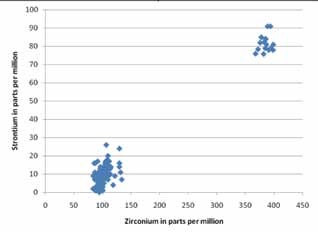
Fingerprints in Stone
Obsidian is formed in an instantaneous geologic event. Because of this, individual sources exhibit homogenous signatures, determined by the relative abundances of trace elements such as strontium (Sr) and zirconium (Zr) from which the material is formed (Glascock et al. 2007). Each source has a unique “fingerprint” that, once identified, can be used to differentiate it from other, distinct sources (Cook 1995, Glascock et al. 2007, Slobodina et al. 2008). For example, Batza Tena exhibits relatively low levels of Sr and Zr, while the Okmok source from the Aleutian Islands has much higher values of both (Figure 3). This anaylsis allows us to trace the material used to make an artifact back to the original geologic location where it was first acquired. For this project we conducted our analyses using X-ray fluorescence (XRF), a non-destructive technique that measures the levels of trace elements in the obsidian without damaging the artifact (Figure 4).
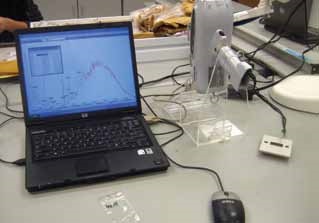
NPS photograph by Jeff Rasic
Previous research efforts in the study area had analyzed 225 obsidian artifacts from 28 sites within Gates of the Arctic. For the current project, 489 additional obsidian artifacts from 133 sites were analyzed, for a total of 714 samples from 160 sites throughout the park area. Four distinct signature groups were identified following the analysis (Figure 6), with a fifth small group (labeled “Unassigned”) requiring re-analysis before a definitive signature can be determined. With most of the obsidian source signatures identified, the next step was to examine the relationship between the source locations and the archaeological sites.
Because site locations are well documented through the archaeological recording process, it was easy to compare them geographically to the location of Batza Tena. All of the 160 sites that we analyzed contained obsidian artifacts which matched the signature for Batza Tena (n=691, 96.78%). However, a total of 12 artifacts (1.68%) from nine of the analyzed sites exhibited signatures that are known archeologically (Groups G, N, and P) but whose geologic source locations remain elusive. While it may be possible that the unknown source groups are related in some way to the Batza Tena source, another possibility suggests that these sources are to be found elsewhere, and the material was transported into the region through trade and interaction.
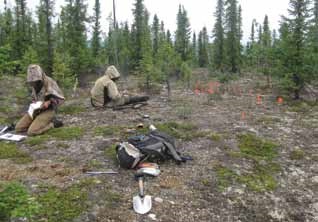
NPS photograph by Chris Cianciabelli
Footsteps of the Past
The cultural boundary in Gates of the Arctic has too commonly been simplified as a line dividing Athabascan and Inupiat (Kunz 1977). In contrast, ethnohistoric research describes how the actual demographics included active and fluctuating interface zones between several populations throughout time (Burch 2005, McFadyen Clark 1974, Raboff 2001). One of the more complex of these interaction zones is in the Upper Kobuk River area. Raboff (2001) suggests that in the proto-historic period of the nineteenth century, home ranges in this region alternated between three different cultural groups: the Kobuk River Inupiat (to the west), the Kobuk River Koyukon (in the headwaters area), and the Too Loghe Koyukon (to the east). We know that archaeologically, Batza Tena obsidian is found throughout Alaska, yet the source area lies well within the known geographic range of the Upper Koyukuk River Koyukon populations. This suggests that the upper Kobuk area may have been cut off from direct access to the Batza Tena source, due to conflicting range boundaries and complex cultural interactions.
However, a well defined network of overland travel routes throughout Gates of the Arctic (Figure 7) shows how cultural interaction and trade of goods in the area crossed these cultural boundaries (Burch 2005, McFadyen Clark 1998). During the time period which these accounts describe, there is little evidence of flaked stone tool manufacture and use (McFadyen Clark 1998). Yet, much of the regional archaeological evidence suggests that an inter-cultural environment, similar to that described above, may have existed into the prehistoric past (Burch and Mishler 1995, Kunz 1977, Raboff 2001). It is reasonable to assume that at least some decades prior to the introduction of Euro-American implements (such as metal tools and firearms which replaced flaked stone tool technology), similar trade networks and travel routes may have been utilized to transport obsidian. The upper Kobuk area specifically presents a sort of nexus of various boundaries and, interestingly, also exhibits the highest occurrence of non-Batza Tena obsidian in a single area.
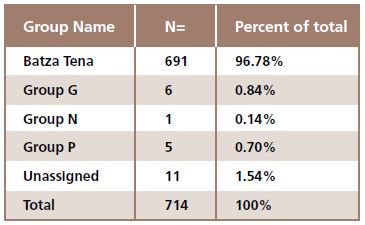
Concluding Remarks
By increasing the database of identified obsidian we have uncovered some tantalizing possibilities regarding resource use in Gates of the Arctic National Park and Preserve. Analysis of the geographic distribution of obsidian has added to our understanding of the nature of prehistoric cultural interaction in the study area, especially in regards to the Kobuk River region. At the very least this provides another line of evidence for understanding the behaviors of the past inhabitants. Our project has also increased the known distribution of archaeological sites containing non-Batza Tena obsidian sources. One of the aims of continuing this type of research is to expand our geographic knowledge of unknown source signatures in an effort to triangulate their original locations on the landscape. The closer we get to understanding the geographic landscape of northwestern Alaska the more we will understand about the people that once lived there.
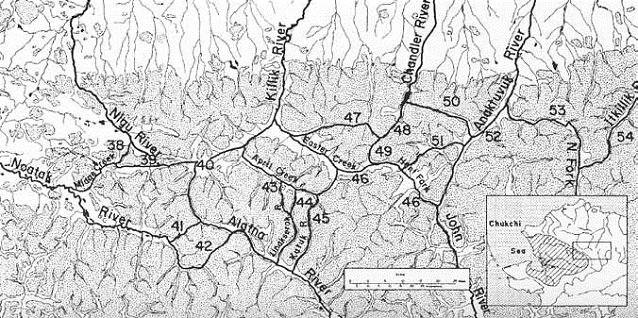
References
Last updated: April 25, 2018
